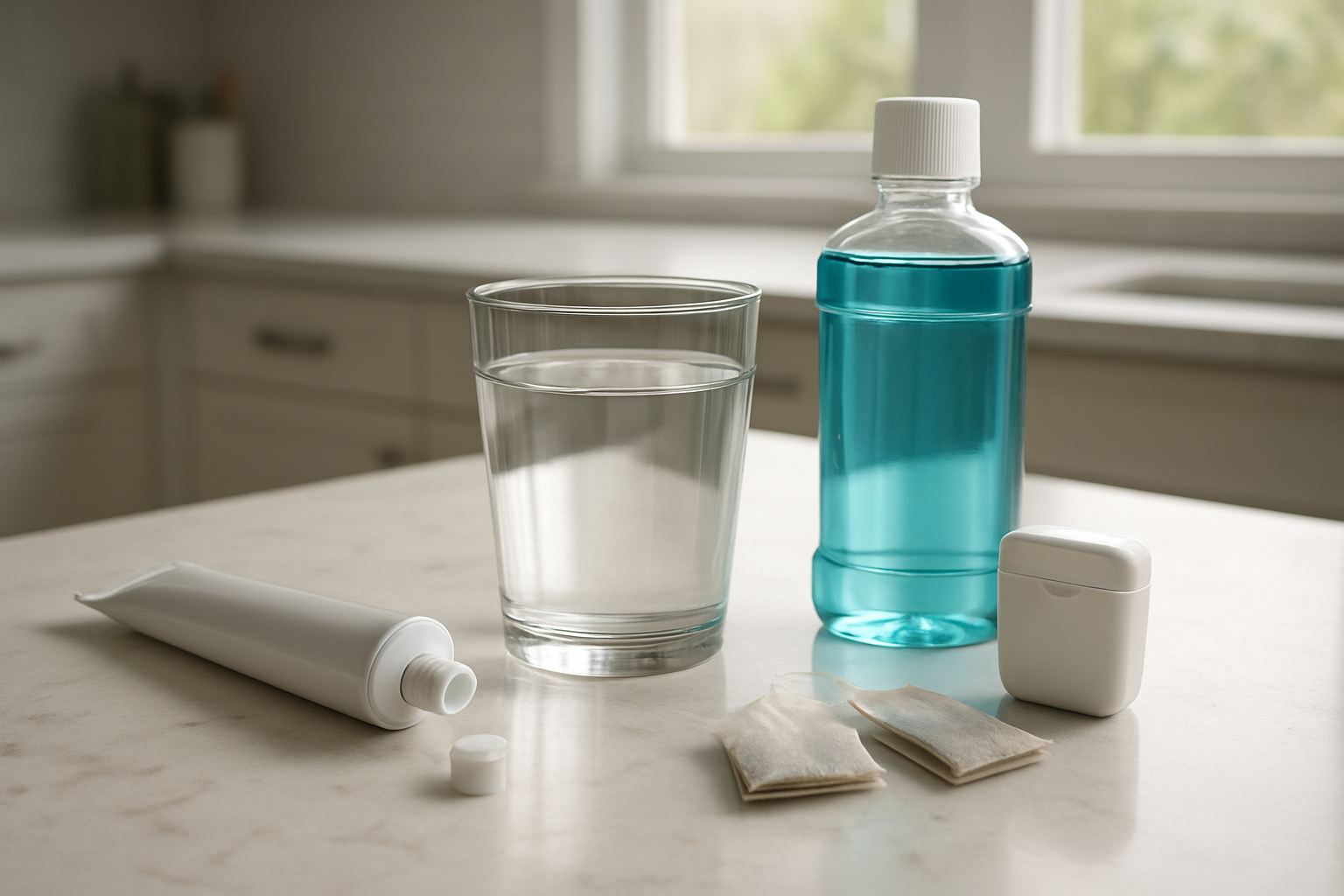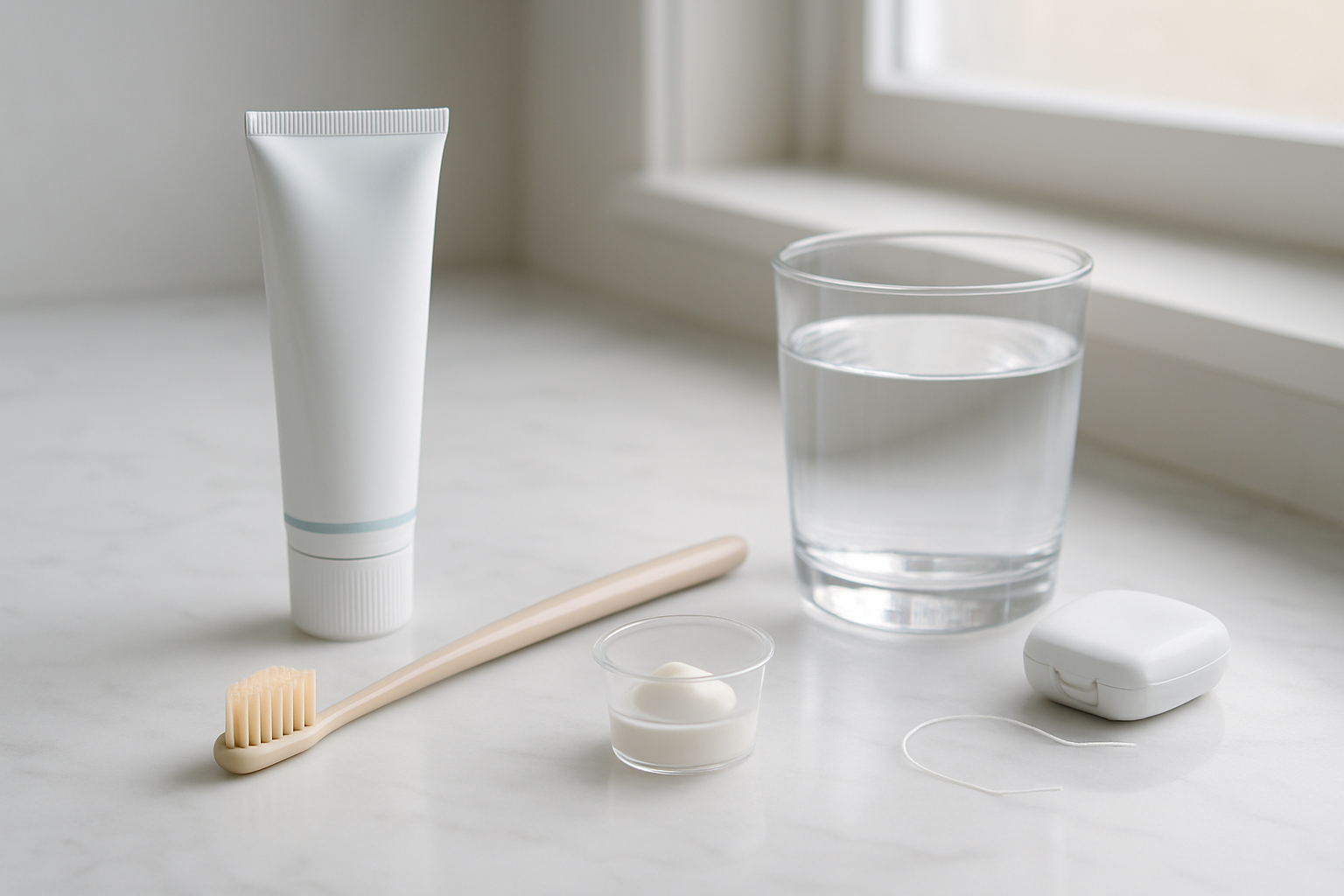Fluoride sparks heated debates in dental offices, parenting groups, and health forums across the country. This guide is for anyone who’s wondered whether that fluoride toothpaste is helping or harming their family, parents questioning fluoride treatments for their kids, and health-conscious adults trying to separate fact from fear-mongering online.
You’ll get straight answers about what fluoride actually does in your body and where you’re getting it every day. We’ll break down the real benefits backed by decades of research, then tackle the legitimate concerns and potential risks you should know about. Finally, you’ll learn practical guidelines for using fluoride safely so you can make confident decisions for your health.
No scare tactics, no industry spin – just the facts you need to understand fluoride’s role in your daily life.
Understanding Fluoride and Its Sources in Daily Life

What fluoride is and how it occurs naturally
Fluoride is a naturally occurring mineral derived from fluorine, the 13th most abundant element in Earth’s crust. You’ll find fluoride compounds scattered throughout the environment in rocks, soil, water sources, and even in the air we breathe. Plants absorb fluoride from the ground, and animals consume it through their diet, making it a natural part of the ecological cycle.
The mineral appears in various chemical forms, with calcium fluoride being the most common natural compound found in rock formations and groundwater. When water passes through fluoride-rich geological formations, it picks up these compounds and carries them into rivers, lakes, and underground aquifers. This process has been happening for millions of years, long before humans discovered fluoride’s dental benefits.
Different regions show dramatically different natural fluoride levels in their water supplies. Some areas have virtually no fluoride, while others contain concentrations well above what’s considered optimal for health. Tea leaves naturally concentrate fluoride from the soil, making tea one of the richest dietary sources of the mineral.
Common sources of fluoride exposure in water and food
Your daily fluoride intake comes from multiple sources, with drinking water typically being the largest contributor. Municipal water systems often contain fluoride either naturally or through artificial addition, providing roughly 0.7 parts per million in optimally fluoridated areas.
Food sources contribute varying amounts of fluoride to your diet:
- Seafood: Fish, shellfish, and seaweed absorb fluoride from ocean water
- Tea: Both black and green tea contain significant fluoride levels
- Grapes and wine: Vineyards often use fluoride-containing pesticides
- Chicken: Poultry raised on fluoridated water and feed
- Infant formula: When mixed with fluoridated water
Cooking with fluoridated water increases the fluoride content of foods, especially rice, pasta, and other grains that absorb large amounts of cooking liquid. Processed foods and beverages manufactured in fluoridated areas also contain higher fluoride levels than those produced elsewhere.
Artificial fluoride additives in dental products
Dental products represent the most concentrated source of fluoride exposure for most people. Toothpaste typically contains 1,000-1,500 parts per million of fluoride, thousands of times higher than water fluoridation levels. Mouth rinses often contain even higher concentrations, ranging from 200-900 parts per million.
Professional dental treatments deliver much stronger fluoride applications:
| Treatment Type | Fluoride Concentration | Application Method |
|---|---|---|
| Fluoride varnish | 22,600 ppm | Brush-on coating |
| Fluoride gel | 12,300 ppm | Tray application |
| Fluoride foam | 12,300 ppm | Tray application |
| Professional rinse | 900 ppm | Swish and spit |
Children’s toothpaste contains lower fluoride concentrations (around 500 ppm) to reduce the risk of fluorosis if swallowed. Many dental products also include different fluoride compounds like sodium fluoride, stannous fluoride, or sodium monofluorophosphate, each offering slightly different properties and benefits.
Government regulations and recommended fluoride levels
Health authorities worldwide have established specific guidelines for optimal fluoride exposure. The U.S. Public Health Service recommends 0.7 milligrams per liter for community water fluoridation, a level designed to maximize dental benefits while minimizing fluorosis risk.
The Environmental Protection Agency sets the maximum allowable fluoride level in drinking water at 4.0 mg/L to prevent skeletal fluorosis, with a secondary standard of 2.0 mg/L to prevent dental fluorosis. These regulations apply to all public water systems serving more than 25 people.
Different countries have adopted varying approaches to fluoride regulation:
- Canada: 0.7 mg/L optimal level, similar to the U.S.
- Australia: 0.6-1.1 mg/L depending on climate
- United Kingdom: 1.0 mg/L in fluoridated areas
- European Union: Most countries don’t fluoridate water but allow fluoridated salt and milk
The World Health Organization supports water fluoridation as safe and effective when properly monitored, recommending levels between 0.5-1.0 mg/L based on climate and dietary factors. Regular monitoring ensures these levels remain within safe ranges and prevents both under-fluoridation and over-exposure.
Proven Health Benefits of Fluoride Consumption

Strengthening Tooth Enamel and Preventing Cavities
Fluoride works like a shield for your teeth, creating a protective barrier that helps prevent tooth decay. When you consume fluoride through water, toothpaste, or other sources, it gets incorporated into your tooth enamel, making it significantly more resistant to acid attacks from bacteria in your mouth. This process transforms the natural hydroxyapatite in your teeth into fluorapatite, which is much harder and more durable.
The protective effect happens in real-time throughout the day. Every time harmful bacteria in your mouth produce acids after you eat or drink something sugary, fluoride helps neutralize these threats before they can create cavities. Research consistently shows that people living in areas with fluoridated water experience 20-40% fewer cavities compared to those without access to fluoride.
What makes fluoride particularly effective is its ability to remain active in your saliva for hours after consumption. This extended protection means your teeth stay defended against decay-causing bacteria even between brushing sessions.
Reducing Dental Decay in Children and Adults
The impact of fluoride on dental health spans all age groups, but the benefits are especially pronounced in children whose teeth are still developing. Studies tracking dental health over decades reveal dramatic reductions in tooth decay rates since widespread fluoride use began.
For children, fluoride provides dual protection. First, it strengthens developing teeth from within as permanent teeth form in the jawbone. Second, it offers ongoing surface protection as children learn proper oral hygiene habits. The combination creates a foundation for lifelong dental health that continues to pay dividends well into adulthood.
Adults benefit from fluoride’s protective qualities too, particularly as they face new challenges like receding gums and age-related changes in saliva production. Older adults who maintain regular fluoride exposure through toothpaste and mouth rinses show significantly lower rates of root decay and secondary cavities around existing dental work.
Population studies from around the world demonstrate consistent results: communities with optimal fluoride levels experience substantial decreases in dental disease across all socioeconomic groups, making it one of the most effective public health measures of the 20th century.
Supporting Remineralization of Weakened Teeth
Beyond preventing new cavities, fluoride actively helps repair early-stage tooth damage through a process called remineralization. When acids from bacteria start breaking down tooth enamel, they create microscopic weak spots that can’t be seen but represent the beginning stages of decay.
Fluoride can actually reverse this early damage by encouraging minerals like calcium and phosphate to redeposit in these weakened areas. This natural repair process happens continuously in your mouth, with fluoride acting as a catalyst that makes the process more efficient and effective.
The remineralization process works best when fluoride levels remain consistently present in your saliva. This is why dentists often recommend fluoride toothpaste twice daily rather than just occasional treatments. The steady, low-level exposure gives your teeth the best chance to repair minor damage before it progresses to visible decay.
Research using advanced imaging techniques shows that teeth exposed to regular fluoride actually become denser and stronger over time. These studies reveal that the remineralization process doesn’t just patch up weak spots – it often leaves teeth more resistant to future acid attacks than they were originally.
Potential Health Risks and Side Effects of Fluoride

Dental Fluorosis from Excessive Fluoride Exposure
When children consume too much fluoride during their tooth development years, they can develop dental fluorosis. This condition shows up as white spots, streaks, or brown discoloration on the teeth. While mild cases might only create barely noticeable white marks, severe fluorosis can cause significant brown staining and pitting of tooth enamel.
The critical window for dental fluorosis occurs between birth and age 8, when permanent teeth are forming beneath the gums. Children who swallow fluoride toothpaste regularly, drink fluoridated water while also taking fluoride supplements, or live in areas with naturally high fluoride levels face higher risks.
Most cases of dental fluorosis in developed countries are mild and primarily cosmetic. However, moderate to severe cases can affect both appearance and tooth structure, potentially requiring cosmetic dental treatment later in life.
Skeletal Fluorosis and Bone Health Concerns
Long-term exposure to high fluoride levels can lead to skeletal fluorosis, a condition where fluoride accumulates in bones and joints. This primarily affects people in areas with naturally high fluoride concentrations in groundwater or those with occupational exposure.
Early stages cause joint pain and stiffness, particularly in the spine and major joints. Advanced skeletal fluorosis can result in:
- Calcification of ligaments
- Bone spurs and joint deformities
- Increased fracture risk
- Restricted movement and mobility issues
The condition develops slowly over 10-20 years of excessive exposure. While rare in countries with regulated water fluoridation, skeletal fluorosis remains a concern in parts of India, China, and Africa where natural fluoride levels exceed safe limits.
Thyroid Function and Hormonal Disruption Risks
Fluoride can interfere with thyroid function by mimicking iodine, an essential element for thyroid hormone production. The thyroid gland can absorb fluoride instead of iodine, potentially disrupting normal hormone synthesis.
Research suggests that fluoride exposure may:
- Reduce thyroid hormone production
- Increase thyroid-stimulating hormone (TSH) levels
- Potentially contribute to hypothyroidism
- Affect metabolism and energy regulation
People with iodine deficiency face higher risks since their thyroid glands more readily absorb fluoride as an iodine substitute. Some studies have found correlations between fluoride exposure and increased rates of hypothyroidism, though more research is needed to establish definitive causal relationships.
Neurological Development Concerns in Children
Recent studies have raised questions about fluoride’s potential impact on children’s brain development. Several epidemiological studies suggest possible links between prenatal fluoride exposure and reduced IQ scores in children.
Areas of concern include:
- Cognitive development: Some studies indicate fluoride exposure during pregnancy may affect children’s intellectual development
- ADHD risk: Limited research suggests potential connections between fluoride exposure and attention deficit disorders
- Memory and learning: Animal studies show high fluoride doses can impact memory formation and learning abilities
The developing brain appears more vulnerable to fluoride’s effects than adult brains. However, most studies showing negative effects involved fluoride levels significantly higher than those found in optimally fluoridated water supplies. The scientific community continues to debate these findings, with some researchers calling for more precautionary approaches while others maintain that current fluoridation levels remain safe for neurological development.
Safe Fluoride Usage Guidelines for Optimal Health

Recommended Daily Fluoride Intake by Age Group
Understanding how much fluoride your body needs changes throughout life. The American Dental Association and World Health Organization provide clear guidelines based on extensive research.
For infants under 6 months, breast milk or formula mixed with low-fluoride water provides adequate amounts. Babies don’t need fluoride supplements during this period. From 6 months to 3 years, children need about 0.1-0.5 mg daily, which they typically get from fluoridated water and a rice grain-sized amount of toothpaste.
Children aged 3-6 years require 0.5-1.0 mg daily. This comes from fluoridated water, food, and a pea-sized amount of fluoride toothpaste. School-age children (6-16 years) need 1.0-2.0 mg daily as their permanent teeth develop.
Adults require 1.5-4.0 mg daily for optimal dental health. Pregnant and breastfeeding women follow the same guidelines as other adults. These amounts prevent tooth decay while staying well below levels that could cause health issues.
| Age Group | Daily Fluoride Intake |
|---|---|
| 0-6 months | From breast milk/formula only |
| 6 months-3 years | 0.1-0.5 mg |
| 3-6 years | 0.5-1.0 mg |
| 6-16 years | 1.0-2.0 mg |
| Adults | 1.5-4.0 mg |
Proper Use of Fluoridated Toothpaste and Mouthwash
Getting the most from fluoride dental products requires proper technique and timing. Most people use too much toothpaste and rinse incorrectly, washing away fluoride before it can work.
For toothpaste, amount matters more than brand. Young children need only a rice grain-sized smear until age 3, then a pea-sized amount until age 6. Adults can use about a half-inch strip. Brushing for two minutes allows fluoride to penetrate tooth enamel effectively.
The rinse-or-not debate has a clear answer: don’t rinse immediately after brushing. Spitting out excess toothpaste while leaving some residue gives fluoride more contact time with your teeth. Wait at least 30 minutes before eating, drinking, or rinsing with water.
Fluoride mouthwash works best when used at different times than brushing, such as after lunch or before bed. Swish for 30-60 seconds, then spit completely. Like toothpaste, avoid rinsing with water afterward. Children under 6 shouldn’t use mouthwash due to swallowing risks.
Professional fluoride treatments at dental offices use higher concentrations and require different care. Don’t eat or drink for 30 minutes after these treatments to maximize benefits.
Monitoring Fluoride Levels in Drinking Water
Water fluoridation programs aim for optimal levels that prevent tooth decay without causing fluorosis. The current recommended level in the United States is 0.7 parts per million (ppm), down from the previous range of 0.7-1.2 ppm.
Most municipal water systems regularly test and adjust fluoride levels, but you can verify your local levels. Contact your water utility company for current fluoride reports, usually available online or by phone. The EPA requires annual water quality reports that include fluoride measurements.
Well water users face different challenges since natural fluoride varies widely by location. Some areas have naturally high fluoride levels that exceed recommended amounts, while others have virtually none. Annual well water testing helps determine if you need fluoride supplements or removal systems.
Home water testing kits provide quick fluoride measurements, though professional lab testing offers more accuracy. If your water contains less than 0.3 ppm fluoride, your dentist might recommend supplements for children. Levels above 2 ppm warrant discussion about filtration systems.
Bottled water fluoride content varies significantly. Most brands contain minimal fluoride unless specifically labeled as fluoridated. Check labels or contact manufacturers for specific fluoride levels if you primarily drink bottled water.
Tracking total fluoride intake becomes important when water levels are high, you use multiple fluoride products, or live in areas with natural fluoride deposits. Simple monitoring prevents both deficiency and excess while maintaining optimal oral health.
Making Informed Decisions About Fluoride in Your Life

Evaluating your personal fluoride exposure levels
Your daily fluoride intake comes from multiple sources, making it essential to understand where you’re getting it and how much you’re consuming. Most people receive fluoride through drinking water, toothpaste, mouth rinses, and certain foods and beverages processed with fluoridated water.
Start by checking your local water utility’s fluoride levels. In the United States, optimal levels range from 0.7 to 1.2 parts per million. Well water users should have their water tested independently, as natural fluoride levels can vary dramatically by location.
Toothpaste typically contains 1,000-1,500 parts per million of fluoride. If you brush twice daily with a pea-sized amount, you’re getting a controlled dose that provides maximum dental benefits. Professional fluoride treatments at dental offices deliver much higher concentrations but occur infrequently.
Foods and beverages also contribute to your intake. Tea, seafood, grapes, and products made with fluoridated water all contain varying amounts. Processed foods and drinks manufactured in areas with fluoridated water can add unexpected fluoride to your diet.
Keep a simple log for a week, noting your water consumption, oral care products, and fluoride-containing foods. This gives you a realistic picture of your total exposure and helps identify areas where you might want to make adjustments.
Consulting healthcare professionals for personalized advice
Your dentist and physician are your best allies in creating a fluoride strategy that works for your specific health profile. They can assess your cavity risk, existing dental work, age-related needs, and any medical conditions that might affect fluoride processing.
Dental professionals evaluate your oral health history, current cavity activity, and saliva production levels. People with dry mouth, frequent cavities, or certain medications may benefit from higher fluoride exposure through prescription toothpaste or professional treatments. Others with excellent oral health might need only minimal fluoride supplementation.
Medical doctors consider your overall health picture, including kidney function, thyroid health, and bone density. They can advise whether your fluoride intake aligns with your body’s ability to process and eliminate it effectively. Pregnant and breastfeeding women need specialized guidance about optimal fluoride levels for both maternal and fetal health.
Pediatric healthcare providers offer crucial guidance for children’s fluoride needs, which change rapidly as teeth develop and dietary habits evolve. They can recommend appropriate fluoride supplements for areas with low water fluoride levels and advise on preventing fluorosis while ensuring adequate cavity protection.
Schedule regular check-ups where fluoride use becomes part of your ongoing health conversation rather than a one-time decision.
Balancing benefits and risks for your family’s needs
Every family’s fluoride needs look different based on genetics, diet, location, and individual health factors. Creating a balanced approach means weighing proven dental benefits against potential risks while considering each family member’s unique circumstances.
| Family Member | Primary Considerations | Recommended Approach |
|---|---|---|
| Infants (0-6 months) | Exclusive breastfeeding/formula | No supplemental fluoride needed |
| Toddlers (6 months-3 years) | Tooth development, swallowing risk | Rice-grain sized fluoride toothpaste, supervised brushing |
| Children (3-6 years) | Permanent teeth forming, fluorosis risk | Pea-sized toothpaste amount, teach spitting |
| Adults | Cavity prevention, existing dental work | Standard fluoride toothpaste, consider mouthwash |
| Seniors | Dry mouth, root decay risk | May need higher fluoride products |
Consider your local environment and lifestyle factors. Families in areas with naturally high water fluoride might choose fluoride-free toothpaste to avoid overexposure. Those in low-fluoride regions might add supplements or higher-concentration dental products.
Budget also plays a role in decision-making. Fluoride toothpaste and fluoridated water provide cost-effective cavity prevention compared to expensive dental treatments. Professional fluoride applications, while more costly upfront, can prevent thousands in future dental work for high-risk individuals.
Regular family discussions about oral health help everyone understand their role in maintaining healthy teeth while using fluoride products safely and effectively.

Fluoride plays a complex role in our daily health routines, offering clear benefits for dental protection while requiring careful attention to safe usage levels. The research shows that when used appropriately, fluoride effectively prevents tooth decay and strengthens enamel, making it a valuable tool in oral health care. However, excessive exposure can lead to dental fluorosis and other health concerns, which is why understanding proper dosing and sources becomes so important.
The key to getting fluoride right lies in balance and awareness. Pay attention to how much fluoride you’re getting from toothpaste, drinking water, and other sources throughout your day. Talk with your dentist about your individual needs, especially if you have children at home who need age-appropriate fluoride levels. By staying informed about both the benefits and risks, you can make confident choices that support your oral health without overdoing it.













